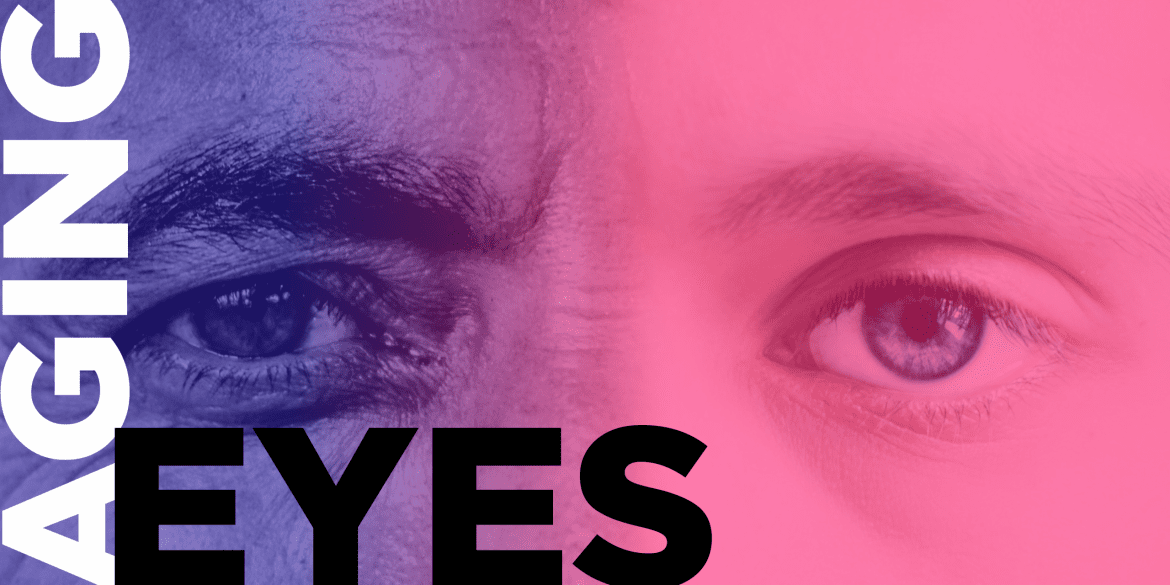![]()
You’re bound to experience changes in your vision as you age.
Perhaps you can’t focus on words at a distance as well as you’re used to. Maybe words up-close fall out of focus, even when you’re wearing glasses.
Small print? You find yourself squinting to read the menu, email, label, or text. Maybe you move what you’re trying to read a bit further away. Maybe you find yourself relocating to a more well-lit room.
These are perfectly normal changes that occur around and after 40. Read on to find out what’s happening and how you can maintain the best possible vision.
What’s happening to your vision?
Presbyopia occurs around age 40. Presbyopia is the declining ability to focus because the lenses of the eyes begin to harden. Suddenly, the eyes have a more difficult time focusing from an object far away to an object close-up. This hardening of the lens leads to less flexibility in the eye, making it more difficult to adjust. As a result, objects appear out of focus.
Presbyopia is a very common, perfectly normal part of the eye’s aging process. In fact, it has been occurring gradually since you were a child. While there is no cure for presbyopia, there are few steps you can take to prolong its effects. This includes wearing reading glasses or getting multifocal lenses or contact lenses for overall improved vision. Refractive or laser surgery may also help to correct issues associated with presbyopia.
Some other common age-related vision issues include:
Glaucoma
According to one study, Americans diagnosed with glaucoma will double in the next year. Glaucoma occurs when there is ocular hypertension, or excess pressure in the eye. In its early stages, glaucoma seldom shows symptoms, but if gone undiagnosed, it can lead to permanent damage to the optic nerve which can then lead to peripheral vision loss and blindness.
Cataracts
Cataracts are extremely common in adults over 40. In fact, they have become so prevalent in senior citizens, cataracts have become recognized as a normal part of the aging process.
Cataracts are a clouding of the lens of the eye and can cause blurry vision, glare, and colors may seem indistinguishable. The good news: cataract surgery is available and can restore your vision to 100 percent.
Loss of color perception
As you age, the cells within the retina responsible for seeing color begin to decline. Colors appear less vivid and have a washed-out quality. The ability to distinguish where one color ends and another begins may also become more pronounced.
Macular degeneration
Macular degeneration, also known as age-related macular degeneration (AMD), is the number one cause of vision loss in adults over 50. AMD causes damage to the center retina, which allows you to see things straight in front of you. In its progressive stages, AMD can cause impairment with driving, reading, and a number of other daily activities.
Dry eye
When the eyes do not produce enough tears, dry eye syndrome occurs. Dry eye can also occur when the eyes don’t produce tears with the right consistency to adequately lubricate the eye. This can happen as result of age or as a side effect of certain medications and occurs frequently in post-menopausal women.
Vitreous detachment
A large portion of the eye is filled with vitreous, a gel that helps the eye retain its shape. Entwined with vitreous gel are fibers attached to the retina.
As you age, the vitreous gel shrinks, causing the fibers to pull away from the retina until they potentially break, causing vitreous detachment. As a result, harmless, but distracting floaters may appear in your vision.
Diabetic retinopathy
Diabetes affects millions of Americans, especially those over 40. Diabetes can also have an affect on the eyes, causing diabetic retinopathy, damage to the retina leading to complete vision loss.
Reduced pupil size
Those who find themselves relocating to a more brightly lit room to read more easily may suffer from a reduction in pupil size.
This frequently occurs in people in their 60s as the result of loss of muscle control within the eye which should regulate reaction to changes in light.
Spotting the symptoms
Getting a routine eye examine is the best line of defense when monitoring age-related vision problems. Doing so may help prevent common problems from doing irreparable damage from hard-to-correct disorders.
Watch out for the following warning signs:
- Images becoming distorted
- Loss of peripheral vision
- Sudden blurry vision
- The appearance of floaters
- Straight lines appearing wavy
In the case of floaters appearing in your line of sight, if they are accompanied by sudden, bright flashing lights, it is important to see your eye doctor right away. Not only could this be a sign of glaucoma, the bright flashing lights may be an indication of a detached retina and should be tended to right away.
Maintaining optimal eye health
There are a number of steps you can take to ensure your eyes stay as healthy as possible for as long as possible.
- Exercise
- Drink 8 to 10 glasses of water a day
- Wear sunglasses in bright sunlight
- Don’t smoke
- When doing household work or playing sports, wear protective eyewear
- Eat a diet loaded with leafy greens and omega-3 fatty acids
- Taking an omega-3 fatty acid supplement
- Keep blood pressure, blood sugar, and cholesterol at healthy levels
Following these steps in accordance with scheduling routine eye exams can help to preserve the longevity of your eye health and slow the progression of several common age-related vision changes.


